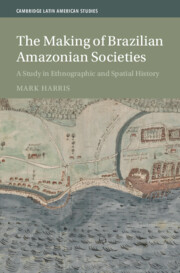Refine search
Actions for selected content:
329 results
Introduction
-
-
- Book:
- How Transparency Works
- Published online:
- 02 January 2026
- Print publication:
- 29 January 2026, pp 1-30
-
- Chapter
-
- You have access
- Open access
- HTML
- Export citation
Conclusion
-
- Book:
- Marriage and the Moral Imagination
- Published online:
- 12 December 2025
- Print publication:
- 22 January 2026, pp 241-254
-
- Chapter
- Export citation
Introduction
-
- Book:
- Marriage and the Moral Imagination
- Published online:
- 12 December 2025
- Print publication:
- 22 January 2026, pp 1-28
-
- Chapter
- Export citation
Ethnography: Tales of the Nonprofit Field
-
- Journal:
- Voluntas: International Journal of Voluntary and Nonprofit Organizations / Volume 33 / Issue 6 / December 2022
- Published online by Cambridge University Press:
- 01 January 2026, pp. 1196-1203
-
- Article
- Export citation
Democracies in the Ethnosphere: An Anthropologist's Lived Experiences of Indigenous Democratic Cultures
-
- Journal:
- Democratic Theory / Volume 8 / Issue 2 / December 2021
- Published online by Cambridge University Press:
- 01 January 2026, pp. 118-138
-
- Article
-
- You have access
- Open access
- HTML
- Export citation

Marriage and the Moral Imagination
-
- Published online:
- 12 December 2025
- Print publication:
- 22 January 2026
9 - Reflections from the Twentieth Century
- from Part II - (Un)Disappearing Black Mexico
-
-
- Book:
- Afro-Mexican Lives in the Long Nineteenth Century
- Published online:
- 20 November 2025
- Print publication:
- 04 December 2025, pp 251-276
-
- Chapter
- Export citation
6 - From Takasago’s Past to Taiwan’s History
-
- Book:
- Negotiating Imperialism
- Published online:
- 08 November 2025
- Print publication:
- 20 November 2025, pp 192-225
-
- Chapter
-
- You have access
- Open access
- HTML
- Export citation

Monotheism and Creation
-
- Published online:
- 17 November 2025
- Print publication:
- 11 December 2025
-
- Element
- Export citation

The Making of Brazilian Amazonian Societies
- A Study in Ethnographic and Spatial History
-
- Published online:
- 14 November 2025
- Print publication:
- 20 November 2025
3 - The Nature–Nurture Debate across Disciplines
- from Part I - Introduction
-
- Book:
- Genes, Brains, Evolution and Language
- Published online:
- 13 November 2025
- Print publication:
- 13 November 2025, pp 77-98
-
- Chapter
- Export citation
Romance as a Method, Enjoyment as Empiricism
- Part of
-
- Journal:
- Public Humanities / Volume 1 / 2025
- Published online by Cambridge University Press:
- 24 October 2025, e150
-
- Article
-
- You have access
- Open access
- HTML
- Export citation
3 - Possession and Enslavement through the Holy Spirit
-
- Book:
- God, Slavery, and Early Christianity
- Published online:
- 19 September 2025
- Print publication:
- 09 October 2025, pp 131-165
-
- Chapter
- Export citation
Chapter 10 - Anthropology and the Deaf and Dumb
- from Part II - Historical and Philosophical Implications
-
-
- Book:
- Kant on Language
- Published online:
- 19 September 2025
- Print publication:
- 09 October 2025, pp 178-196
-
- Chapter
- Export citation
4 - Enslaved Surveillance and Spirit–Flesh Symbiosis
-
- Book:
- God, Slavery, and Early Christianity
- Published online:
- 19 September 2025
- Print publication:
- 09 October 2025, pp 166-199
-
- Chapter
- Export citation
21 - Liturgy as Ritual (and Prayer)
- from Part V - The Study of Liturgy
-
-
- Book:
- The Cambridge Companion to Christian Liturgy
- Published online:
- 19 September 2025
- Print publication:
- 09 October 2025, pp 369-388
-
- Chapter
- Export citation
1 - Skirmishes
-
- Book:
- The War on Tenure
- Published online:
- 30 September 2025
- Print publication:
- 30 September 2025, pp 1-8
-
- Chapter
- Export citation
2 - Shepherd
- from Part One - Getting to Tenure
-
- Book:
- The War on Tenure
- Published online:
- 30 September 2025
- Print publication:
- 30 September 2025, pp 11-15
-
- Chapter
- Export citation
Cooperation in Polarized Legislatures: Learning from the Case of the Texas State House of Representatives
-
- Journal:
- State Politics & Policy Quarterly / Volume 25 / Issue 4 / December 2025
- Published online by Cambridge University Press:
- 19 September 2025, pp. 464-488
- Print publication:
- December 2025
-
- Article
-
- You have access
- Open access
- HTML
- Export citation
Psychiatrists, Penguins and Pelicans: media psychiatrists and psychiatrists in the media – CORRIGENDUM
-
- Journal:
- BJPsych Bulletin , FirstView
- Published online by Cambridge University Press:
- 26 August 2025, p. 1
-
- Article
-
- You have access
- Open access
- HTML
- Export citation
